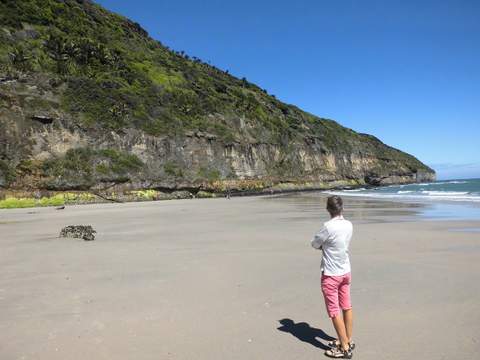Death of the dinosaurs

VulcanSpirit
Richard & Alison Brunstrom
Sun 15 Dec 2013 11:50
|
Our recent trip to the less visited Golden Bay area
took us to Cape Farewell (named by Cook on his first voyage as his last sight of
NZ), the northernmost part of South Island. Scenically and geologically this is
a very interesting place:
 The slim and elegant crewperson of the Vulcan
Spirit is looking at a boundary in the rocks, an 'unconformity', a couple of
metres above the beach. Above the boundary the rocks are fine sedimentary types,
laid down in the early Miocene 'only' about 20 million years ago. But below that
the rock is completely different:
 This lower rock is much older and as you can see it
is largely composed of rounded pebbles (the green stuff is seaweed), with
the much finer-grained rock clearly visible above Alison's head. This pebbly
stuff is called a conglomerate; the pebbles themselves are mostly granite, but
ancient granite. This rock is interpreted as being the remains of a large
braided river, laid down right at the very end of the Cretaceous about 65
million years ago - that's to say right at the very end of the age of dinosaurs,
just before the meteor impact in Mexico saw them all off. Dinosaurs would have
been wading this very river! And amazing to think that those granite pebbles
were themselves ancient by then (I don't know how ancient), having already been
extruded from a volcano, then eroded out of a bedrock, then rounded in the river
before being 'frozen' again into the new conglomerate. For some reason this spot
really brought home the immensity of geological time; yet this rock is young by
comparison with the 4.5 billion year age of the
earth.
|